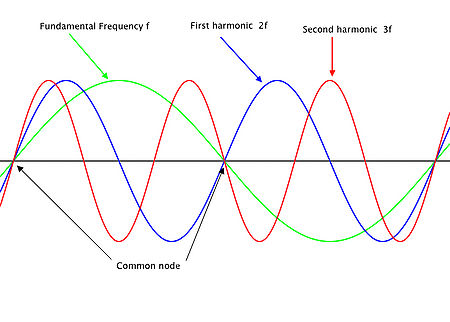Harmonics: Difference between revisions
(re-drew harmonics graph) |
(added internal link) |
||
| Line 1: | Line 1: | ||
Related wiki pages: [[Antennas]], [[Propagation]], [[Interference]], [[Gain]], [[SWR]] | Related wiki pages: [[Antennas]], [[Propagation]], [[Interference]], [[Gain]], [[SWR]], [[Frequency Wavelength and Period]] | ||
==What is an harmonic?== | ==What is an harmonic?== | ||
Revision as of 22:36, 18 December 2008
Related wiki pages: Antennas, Propagation, Interference, Gain, SWR, Frequency Wavelength and Period
What is an harmonic?
An harmonic of a particular frequency (the fundamental frequency f) is another frequency that is an integer multiple of the first one. For example:
if f = 125MHz, the harmonics would be: 2f = 250MHz, 3f = 375MHz, 4f = 500MHz ..... etc
In the diagram below it can be seen that harmonics share common nodes.
Mathematically, the basic wave equation is:
<math> \mathit{v}=\mathit{f}\times \lambda </math>
v is the velocity of the wave in metres per second - a constant close to the speed of light for radio waves in the atmosphere.
f is the frequency of the wave - how many cycles pass a fixed point per second
<math> \lambda </math> is the wavelength of the wave in metres - the distance between two peaks of the wave.
So, as the frequency increases, the wavelength decreases - a doubling of frequency causes a halving of wavelength etc.
